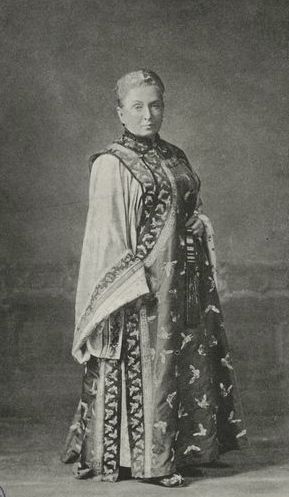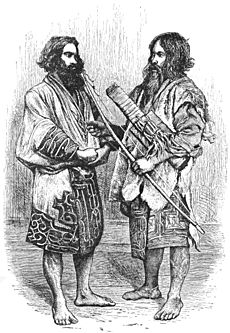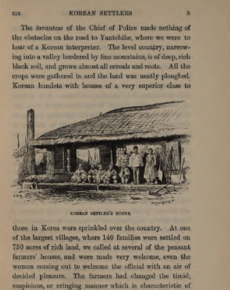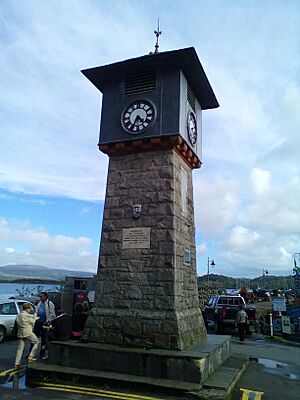Isabella Bird facts for kids
Quick facts for kids
Isabella Bird
|
|
|---|---|
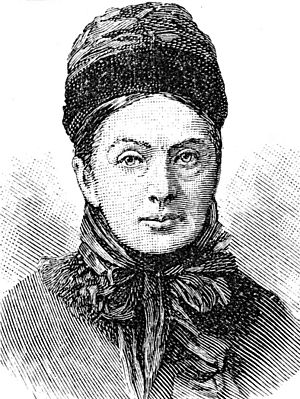 |
|
| Born |
Isabella Lucy Bird
15 October 1831 Boroughbridge, Yorkshire
|
| Died | 7 October 1904 (aged 72) Edinburgh, Scotland
|
| Resting place | Dean Cemetery, Edinburgh |
| Occupation | Writer, photographer and naturalist |
| Spouse(s) | John Bishop (m. 1881) |
| Parent(s) | Dora Lawson, Edward Bird |
Isabella Lucy Bishop (born Bird; 15 October 1831 – 7 October 1904) was an amazing English explorer, writer, photographer, and naturalist. She traveled all over the world and wrote popular books about her adventures. Isabella also helped start the John Bishop Memorial Hospital in Srinagar, Kashmir. She made history as the first woman to become a member of the important Royal Geographical Society.
Contents
Isabella's Early Life & Health
Isabella Bird was born on 15 October 1831 in Boroughbridge, Yorkshire. Her parents were Reverend Edward Bird and Dora Lawson. Her family moved several times during her childhood. In 1832, they moved to Maidenhead. Then, in 1834, they moved to Tattenhall in Cheshire.
Isabella was very outspoken even as a young child. When she was six, she bravely spoke to a local politician. She asked him if he had complimented her father's family just to get his vote! In 1848, her family moved again to Wyton in Cambridgeshire.
From a young age, Isabella was often unwell. Doctors suggested she spend time outdoors. Because of this, she learned to ride horses and row boats. Her parents taught her everything she knew. Her father taught her about plants, and her mother taught her many different subjects. Isabella loved to read and was very curious about the world.
First Adventures & Writings
Isabella's first writing was a short paper about trade when she was just 16. After that, she kept writing articles for different magazines.
In 1854, Isabella's life of travel began. Doctors thought a sea voyage would help her health. She sailed to the United States with her cousins. Her father gave her money and told her to stay as long as it lasted. Isabella wrote exciting letters home to her family. These letters became her first book, An Englishwoman in America, published in 1856. The publisher, John Murray, became a close friend.
Exploring the World: Middle Life Travels
Isabella left Britain again in 1872. She first went to Australia, which she did not enjoy. Then she traveled to Hawaii, which she loved. Her experiences there led to her second book, published three years later. While in Hawaii, she climbed two large volcanoes, Mauna Kea and Mauna Loa.
Next, she went to Colorado in the United States. She had heard the air there was good for health. In 1873, she rode over 800 miles through the Rocky Mountains. She dressed practically and rode like a man, not sidesaddle. Her letters to her sister about these adventures were printed in a magazine. They later became her most famous book, A Lady's Life in the Rocky Mountains.
In the Rockies, Isabella met a famous outlaw named Jim Nugent. He was known as "Rocky Mountain Jim." Isabella found him fascinating, but she eventually left the Rockies. Jim Nugent was sadly killed less than a year later.
Back home, Isabella was pursued by Dr. John Bishop, a surgeon from Edinburgh. She became interested in Japan and traveled to Asia in 1878. She visited Japan, China, Korea, Vietnam, Singapore, and Malaya.
In 1880, her sister Henrietta died. After this, Isabella accepted John Bishop's marriage proposal. They married in February 1881. Later that year, the King of Hawaii gave her a special award. Isabella's health improved after John Bishop passed away in 1886. She inherited money from him and decided to travel as a missionary. Even though she was almost 60, she set off for India.
Later Journeys & Achievements
Isabella arrived in India in February 1889. She visited missions and traveled to Ladakh, near Tibet. She also explored parts of Persia, Kurdistan, and Turkey. In India, the Maharajah of Kashmir gave her land. She used this land to build a hospital for women, working with Fanny Jane Butler. This hospital, the John Bishop Memorial Hospital, was named after her late husband.
The next year, she joined British soldiers traveling between Baghdad and Tehran. She even carried a revolver and a medicine chest. In 1891, she traveled through Baluchistan to Persia and Armenia. She explored the source of the Karun River. Later that year, she spoke in the House of Commons about the unfair treatment of Christians in Kurdistan.
Isabella Bird became very famous. In 1890, she was the first woman to receive an Honorary Fellowship from the Royal Scottish Geographical Society. Two years later, she became the first woman allowed to join the Royal Geographical Society. She also joined the Royal Photographic Society in 1897.
Her last big journey was in 1897. She traveled up the Yangtze and Han rivers in China and Korea. After that, she went to Morocco. There, she traveled among the Berbers and rode a black horse given to her by the Sultan.
Isabella's Final Years
A few months after returning from Morocco, Isabella Bird became ill. She passed away at her home in Edinburgh on 7 October 1904. She was buried with her family in Dean Cemetery. At the time of her death, she was planning another trip to China.
Isabella's Legacy
Isabella Bird's life story has inspired many. The first book about her was written in 1907. She was also a character in a play called Top Girls (1982). In 1985, she was honored by being inducted into the Colorado Women's Hall of Fame.
Isabella Bird's travels in Japan are featured in a manga series called Isabella Bird in Wonderland. This series tells the story of her adventures.
Isabella funded the building of a clock tower on the harbor wall in Tobermory, Mull. She built it in memory of her beloved sister, Henrietta. The famous mountaineer Edward Whymper designed it.
In 2022, a TV show called Trailblazers: A Rocky Mountain Road Trip followed her steps in Colorado. In July 2023, a tourism event in Kaneyama, Japan, celebrated her travels there.
Isabella's Books
- The Englishwoman in America (1856)
- The Hawaiian Archipelago (1875)
- A Lady's Life in the Rocky Mountains (1879)
- Unbeaten Tracks in Japan (1880)
- The Golden Chersonese and the way Thither (1883)
- Journeys in Persia and Kurdistan (1891)
- Among the Tibetans (1894)
- Korea and her Neighbours (1898)
- The Yangtze Valley and Beyond (1899)
- Chinese Pictures (1900)
- Notes on Morocco (published in the Monthly Review) (1901)
Images for kids
See also
 In Spanish: Isabella Bird para niños
In Spanish: Isabella Bird para niños
- Anna Wolfrom - first female homesteader, successful businesswoman, and playwright


